Why Your Home's Hidden Plumbing System Needs Professional Attention
Plumbing inspection service is a comprehensive examination of your home's water supply, drainage systems, and fixtures to identify potential problems before they become costly disasters. If you're curious about how a home plumbing system works overall, this overview from Wikipedia is a good primer: plumbing system.
Quick Facts:
- What it includes: Visual checks of pipes, fixtures, water heater, plus optional camera inspection of sewer lines
- How often: Every 2 years for most homes, annually for homes over 40 years old
- Who performs it: Licensed plumbers or certified home inspectors
- Time required: 1-2 hours for standard inspection
- Main benefits: Prevents water damage, catches issues early, protects property value
Most homeowners focus on what they can see - leaky faucets, running toilets, or slow drains. But the reality is that the majority of your home's plumbing system is hidden behind walls and beneath floors, making it nearly impossible to spot problems until significant damage occurs.
A plumbing inspection goes beyond surface-level checks. Professional plumbers use specialized tools like sewer cameras and pressure testing equipment to examine areas you'll never see. They can detect everything from small leaks that cause mold growth to tree roots infiltrating your main sewer line.
Think of it as a preventive health checkup for your home's circulatory system. Just as you wouldn't skip annual medical exams, your plumbing deserves the same proactive care. The alternative - dealing with burst pipes, sewage backups, or foundation damage - can cost thousands more than a simple inspection.
Whether you're buying a home, selling one, or simply want peace of mind, understanding how plumbing inspections work will help you make informed decisions about this essential service.
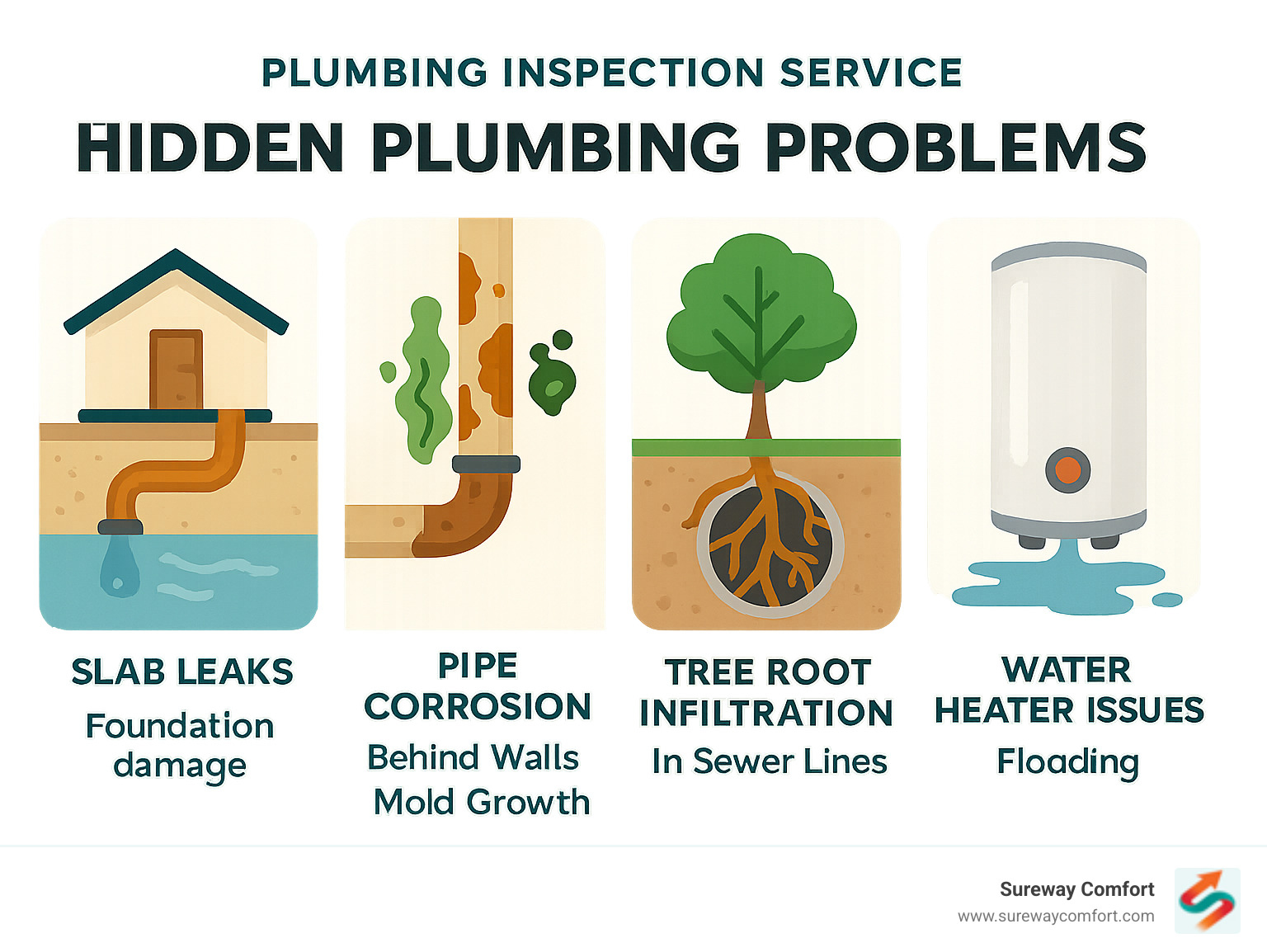
Why a Plumbing Inspection is Your Home's Best Friend
Think of your home's plumbing like the circulatory system in your body - when it's working well, you barely notice it. But when something goes wrong, it can affect everything else. That's exactly why a plumbing inspection service isn't just another item on your home maintenance checklist - it's one of the smartest investments you can make.
Your home is probably your biggest financial investment, and its plumbing system works around the clock to keep your family comfortable and healthy. Yet most of this crucial infrastructure is completely hidden from view. Behind your walls, under your floors, and beneath your foundation, miles of pipes carry fresh water in and waste water out. Without regular professional attention, small problems can quietly grow into expensive disasters.
Preventive maintenance through regular plumbing inspections is like getting an annual physical - it catches problems while they're still small and manageable. That tiny leak behind your bathroom wall might seem harmless now, but left unchecked, it could lead to thousands in water damage, mold remediation, and structural repairs. An inspection spots these issues early, when fixing them costs hundreds instead of thousands.
The cost savings alone make inspections worthwhile. Consider this: clearing a clogged drain costs a few hundred dollars, but replacing a collapsed sewer line can run into the thousands. When you factor in potential water damage to flooring, walls, and personal belongings, the financial protection becomes even more significant.
Regular inspections also protect your property value. A well-maintained plumbing system is a selling point that buyers appreciate, while undisclosed plumbing problems can derail a sale or force you to accept a lower offer. Plus, many insurance companies look more favorably on claims when they see you've been proactive about maintenance.
Signs You Need an Inspection Now
Your home has a way of telling you when something's wrong - you just need to know what to listen for. Some warning signs demand immediate attention from a plumbing inspection service.
Slow drains are often the first sign of trouble brewing. When water takes longer than usual to disappear down your sink or shower, it might indicate a developing blockage deep in your pipes or even tree roots growing into your sewer line.
Low water pressure throughout your home suggests bigger issues than a clogged showerhead. It could mean mineral buildup in your pipes, corrosion, or problems with your main water supply line. If just one fixture has low pressure, that's usually an easy fix. But when multiple fixtures are affected, it's time for a professional look.
Gurgling sounds from your drains or toilets aren't normal - your plumbing shouldn't sound like a haunted house! These noises often point to blockages or ventilation problems in your drainage system.
Foul odors coming from drains can indicate sewer gas leaks, significant blockages, or problems with your home's vent system. These aren't just unpleasant - they can be health hazards too.
A sudden spike in your water bill without increased usage is like your wallet's smoke alarm going off. It almost always means you have a hidden leak somewhere, possibly in walls, under your foundation, or in underground pipes.
Stains on walls or ceilings, damp spots, or peeling paint are classic red flags for hidden water leaks. These visual clues often appear long before you notice any other symptoms, making them crucial early warning signs.
If your home is over 40 years old, your plumbing system might be approaching the end of its expected lifespan or contain outdated materials. Older homes benefit from annual inspections, while newer homes typically need professional attention every two years.
For Home Buyers and Sellers
Real estate transactions involve huge sums of money, and plumbing problems can make or break a deal. A plumbing inspection service serves as crucial protection for both buyers and sellers.
For buyers, a thorough plumbing inspection goes far beyond what a standard home inspection covers. While general home inspectors check basic function - do the toilets flush, do the faucets run - they often miss serious issues hiding in sewer lines or behind walls. A specialized plumbing inspection, especially one including camera inspection of sewer lines, can reveal problems like corroded pipes, tree root infiltration, or cracks in your main sewer line before you sign on the dotted line.
This knowledge gives you negotiation power. You can ask the seller to handle repairs, adjust the purchase price, or even walk away from a property that could become a money pit. It's much better to find these issues before you own them rather than after you've moved in.
For sellers, getting ahead of potential problems with a pre-listing plumbing inspection can transform a liability into a selling advantage. Addressing any issues before you list prevents last-minute surprises that could delay or derail your sale. A clean inspection report becomes a powerful marketing tool, giving buyers confidence in your property's condition and potentially supporting a higher asking price.
Being proactive also helps ensure your seller disclosures are accurate and complete, protecting you from potential legal issues down the road. In today's competitive market, demonstrating that your home's systems are well-maintained can make your property stand out from similar listings.
The Anatomy of a Professional Plumbing Inspection
When you schedule a plumbing inspection service, you're getting much more than a quick look around your pipes and fixtures. Understanding what goes into a thorough inspection helps you appreciate why this investment is so valuable for your home's health and your peace of mind.
The key difference lies in who's doing the work and how deep they dig. A standard home plumbing inspection involves either a trained plumber or a home inspector, but the scope can vary dramatically. A typical home inspector will check that your drains work, toilets flush, and faucets turn on. They'll look for obvious leaks and make sure your water heater isn't about to explode. It's a solid surface-level check, but it's designed to cover a lot of ground quickly.
A professional plumber, however, brings specialized knowledge and diagnostic tools that can uncover problems hiding in places you'd never think to look. They understand how your entire system works together, from the main water line coming into your house to the sewer line carrying waste away. They know what signs to watch for that indicate trouble brewing behind your walls or under your foundation.
The real magic happens when plumbers use advanced diagnostic tools like sewer cameras, pressure testing equipment, and specialized leak detection devices. These aren't just fancy gadgets - they're essential for finding problems that could cost you thousands later. A trained eye can spot early signs of corrosion, identify code compliance issues, and catch small problems before they become big headaches.
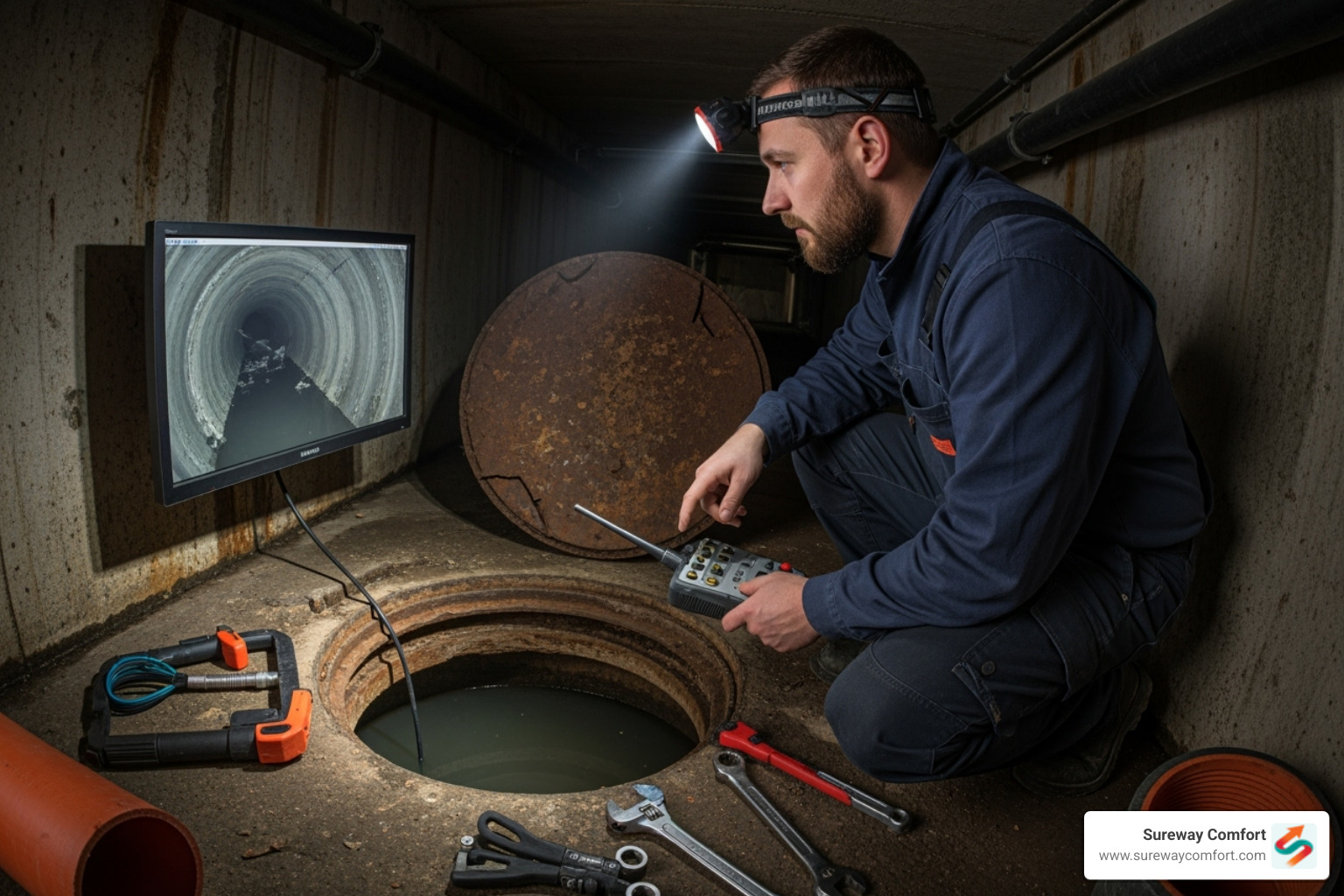
Types of Plumbing Inspections
Not every plumbing inspection service is the same, and understanding your options helps you choose what's right for your situation and budget.
A visual inspection forms the foundation of any good plumbing check-up. Your plumber will examine every accessible pipe, fixture, and connection they can see. They're looking for obvious signs of trouble: dripping faucets, corroded pipes, water stains, or fixtures that aren't working properly. This hands-on approach catches many common issues and gives your plumber a good sense of your system's overall condition.
But here's where things get interesting. A camera inspection takes you into the hidden world of your plumbing system. Using a high-resolution, waterproof camera attached to a flexible cable, plumbers can travel through your drain lines and sewer pipes, seeing exactly what's happening inside. This technology reveals problems that would otherwise stay hidden until they cause serious damage - things like tree roots growing into your pipes, cracks developing in your sewer line, or blockages forming deep in your system.
For homes with persistent drainage issues or suspected underground leaks, hydrostatic pressure testing provides definitive answers. This method involves sealing your sewer line and filling it with water, then monitoring whether the water level drops. If it does, you've got a leak somewhere in your underground plumbing that needs attention before it causes foundation problems or creates an expensive mess.
| Inspection Type | What's Checked | Best Use Cases |
|---|---|---|
| Visual Inspection | All accessible pipes, fixtures, water heater, outdoor spigots, visible connections and fittings | Regular maintenance, pre-purchase inspections, general system health check |
| Camera Inspection | Interior of drain lines and sewer pipes, identifying blockages, cracks, root intrusion, pipe condition | Recurring drain problems, older homes, before major renovations, suspected sewer line issues |
What's on the Checklist? A Comprehensive Look
When a professional plumber conducts your plumbing inspection service, they're following a systematic approach that covers every part of your water and waste systems. A home inspector looks at the main plumbing components in a home, but a specialized plumbing inspection goes much deeper.
Inside your home, every fixture gets individual attention. Your plumber will test each toilet's flush rate and check how quickly the tank refills. They'll run water in every sink, shower, and tub, watching how well drains perform and checking for leaks around faucets and fixtures. The water heater examination is particularly thorough - they'll check the temperature settings, test the pressure relief valve, inspect all connections, and make sure the unit is operating safely and efficiently.
Outside your home, the inspection extends to hose bibs, outdoor faucets, and any visible supply lines. But the real detective work happens with your main sewer line, where a video camera inspection of the sewer pipes will be performed to identify potential problems lurking underground.
Hidden systems throughout your house get special attention too. Your plumber will examine pipes running through walls and floors wherever they're accessible, check your home's main water shut-off valve location and operation, and inspect any sump pumps or water filtration systems you might have.
The beauty of a comprehensive inspection lies in how all these individual checks come together to create a complete picture of your plumbing health. Your plumber isn't just looking for problems - they're assessing how well your entire system works as a team and identifying areas that might need attention down the road.
For homeowners in Bridgeville, South Fayette, Upper St. Clair, Mt. Lebanon, McDonald, Scott Township, Canonsburg, and Bethel Park, Sureway Comfort makes inspections simple with a streamlined process, experienced technicians, maintenance plans, and flexible financing options. Ready for peace of mind? Contact Sureway Comfort to schedule your plumbing inspection today.



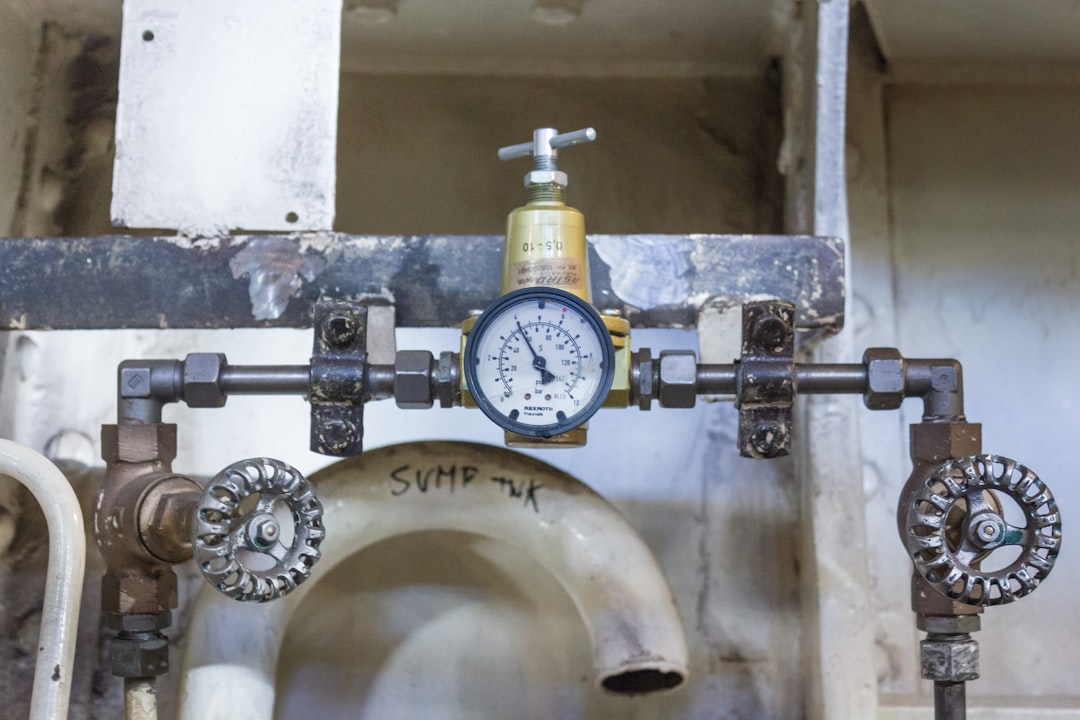
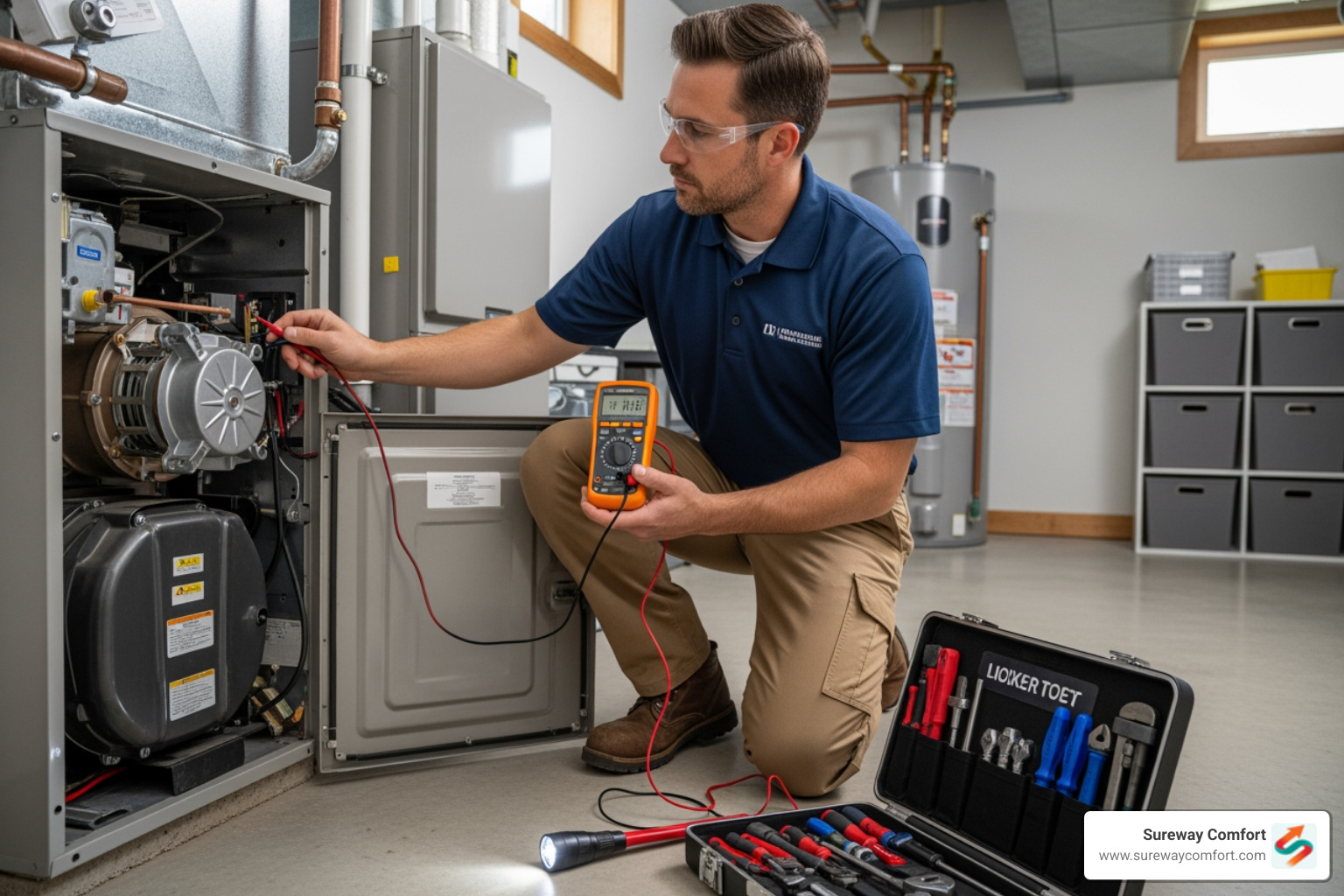

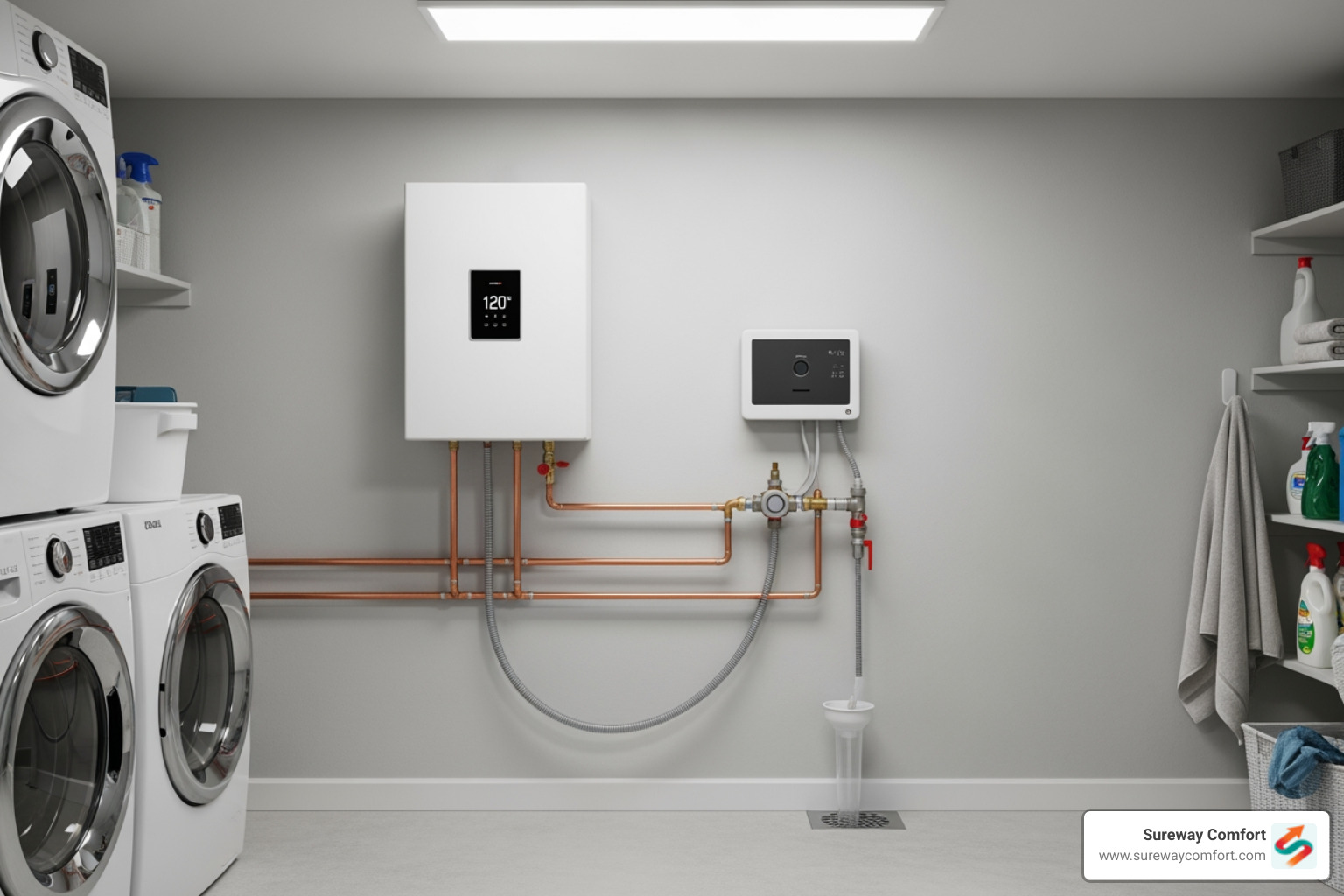





















.avif)



